Confessions of an amateur pensioner
It is traditional at Christmas for people you haven't seen to send you long boring letters documenting all their activities during the year. Just when you thought you were safely passed Christmas, here comes another one
I guess the most amazing thing about retirement is that I actually lived long enough to enjoy it. Not something I would have put money on, particularly after my heart failure episode. So I can now divulge my remedy for heart problems. It's quite simple, make it work. Lots of double digging (Nick will know what that is), concrete mixing, tree planting and anything else that makes your muscles scream and your blood pound. There will be one of two outcomes, either your ticker will stop completely, or it will get stronger; either way you won't have to live like some cripple, dependant on drugs. I am now strong enough to last for another ten years or more, which of course means that the inoperable tumour should make its presence felt very soon. C'est la guerre.
Of bricks and men
I have learned some new skills since lifting my head from a computer screen. Managing a house extension project was one of them, which I thoroughly enjoyed and I learned a few things:
A component of my project management technique was three dimensional representations of the brickwork details, interior fitting positions and levels, which I handed out on an almost daily basis. To produce these, I found a useful piece of software. Now, I don't often use the words useful and software in the same sentence, but the Google Sketchup tool is a Swiss army knife for all 2D and 3D drawings and its' free. I started off using TurboCad, but it took so long to produce anything that I was loath to change details once I had got the first version working. With Sketchup I can just throw together the bare bones of a design and true it up with accurate dimensions if and when I need to. I found it first on a woodworking site as it is popular with furniture makers. Here is a small sample of what is possible with little or no effort.
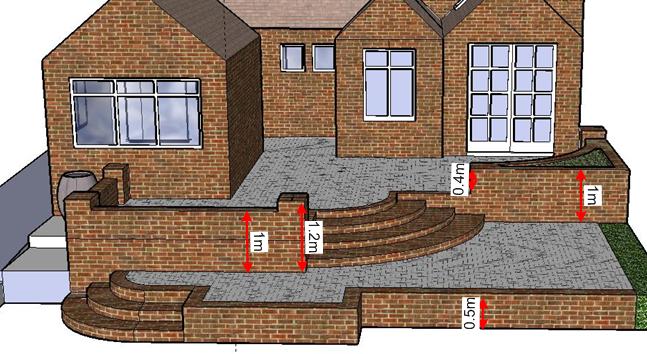
Without such a tool, I know that the complex layout of the two level patio area and stairways would not have been successfully transferred from plan to real bricks
Needless to say, the house turned onto a much bigger project than we started out with, but at least that was our decision and not scope creep. We ended up with two extra rooms, a knocked through living room and a much bigger kitchen, but funnily enough, just the same amount of junk that we have no room for as when we started. I think it's down to quantum; a house contains a load of dark matter that crowds out the stuff you can see.
Those of you who care about the environment might not want to read this paragraph because, you see, we did not stop at the house. We also lopped a couple of hundred feet off the top of mount Everest to supply the Himalayan slate that covers the ground from a driveway off the road through to patio areas halfway down the back garden. So now, as you approach the front door, you step on a couple of fossilized fern leaves, or maybe dinosaur feathers. What carbon footprint?
By now you are probably thinking "why are these idiots spending so much money on their house when property prices are tumbling?" Well, taking everything we have spent, from our bargain basement purchase up until today, at today's prices, and assuming that house prices drop another 15%, we are still looking at a return of about 8% per annum over twelve years. Much better than any other investment we could have made.
We have put our move to France on hold until mother in law dies, which should happen in about 300 years. We can't be certain, as we don't know what stock of virgin's blood she has left. She was meant to move in with us, but we are too boring and besides, we don't dress for dinner.
Alan the builder
Last October, we left the house extension work with the link between the patio and the ground level unfinished, largely because we had not at that time decided on the design. So this year, I am going to try to complete it myself.
The design we finally agreed on looks like this:
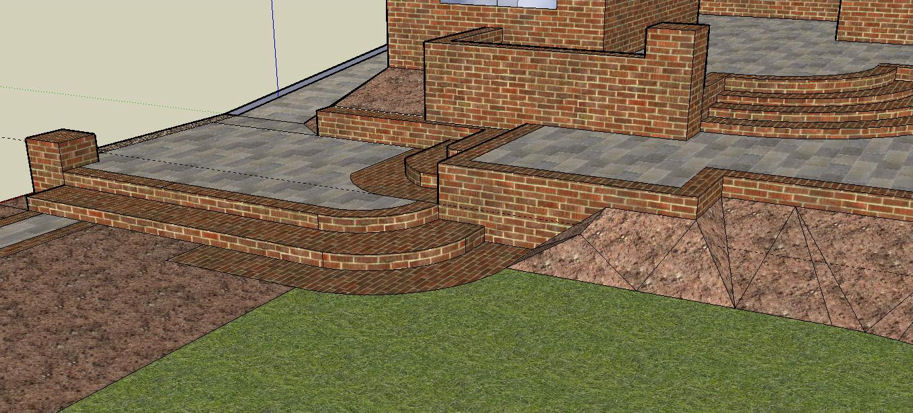
And the current reality looks like this.
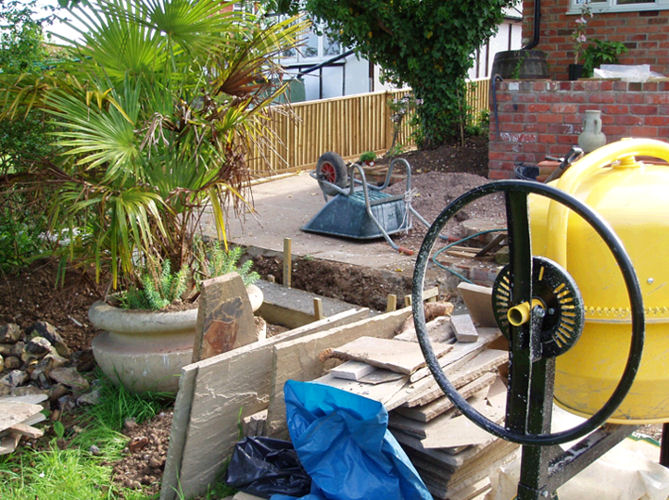
The palm tree in the pot was originally up near the house and was moved out of the way of the building work by a digger nudging it. It is theoretically possible that we could move it with some block and tackle gear, but the current plan is to remove the tree and replant it elsewhere. The concrete mixer in the foreground is the latest recruit to my tool collection and it actually works out cheaper to buy than to hire. I picked up lots of tips from the builders, so I know all about the correct slump for concrete and what depth of scalpings I need for a given weight of patio slab, so what could go wrong. Well, over the next couple of months we shall see. At the very least I can get the footings done and bring in a bricklayer if I fail to lay a level row of bricks.
Slug wars
Following Nick's pioneering example, I have taken up serious vegetable growing. I have dabbled for some time, but I thought that being an impoverished pensioner I needed to cut back on expenditure. Otherwise I would not be able to afford the 19th century Disston crosscut saw or the titanium framing hammer I have been looking at, which is a snip at £179.99.
Anyway, I am now digging for victory, which has not only given me a whole new set of tool catalogues to study, but even some of my own home grown produce. 2008 was the first production year and was a partial success. My corn, whilst not as high as an elephants eye, did reach the shoulder of a small donkey. The cabbage grew well, for which the slugs were very grateful, but carrots and onions were a miserable failure.
However, this year, I have got a real production system going, with crops moving in succession from seed trays on window sills to pots in the greenhouse and, after a suitable period of acclimatization, to their final resting place in well prepared ground.
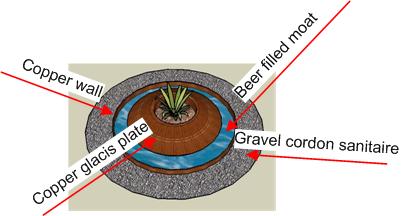
I am also better prepared for slug wars part 2. On the left is my design for a slug protection zone, which is completely organic and guaranteed to work. You first dig a hole one metre in diameter and 940 mm deep, covering the bottom with pond liner. Into this you sink a one metre deep outer copper wall, so that 940 mm is below ground, Now place an inner copper wall, also one metre deep, into the hole and glue the outer and inner walls to the pond liner to form a waterproof moat 940 mm deep, which should be filled with warm beer. The inner area can now be filled with soil, which should be first sterilised by steaming over a charcoal fire for twenty four hours. Finally fit the copper glacis plate over the inner wall, surround the edifice with a gravel bed and plant a cabbage in the centre. The only problem is that each cabbage costs £24 to grow, but I am sure that I could get the cost down with mass production.
As a backup plan, I understand that frogs and toads enjoy munching on slugs and the Australian Department of Agriculture say that they can supply me with as many cane toads as I require. Again, a totally organic solution; with the added benefit that children will learn lots about wild life by watching the toads hop merrily around the garden.
In fact, slugs have not yet appeared this year and neither have any carrots. Everything is growing away like mad, but, for the second year running, there is no sign of a carrot. I am going to try one more sowing before I give up on them. The irony is that carrots are supposed to be the easiest vegetable to grow.
Loss of a hero
Earlier in the year, our neighbour George died. He was one of the most beautiful people I have known. He was a great neighbour who would do anything for anyone, was always cheerful and still cycled two miles to the supermarket right up to a week before he died at the age of 86. He was a Reading boy and, apart from war service in the navy, spent his whole life in the town; working for many years in the Courage brewery.
He spent his long retirement caring for his terminally ill wife, visiting sick work mates and looking after the less active people on the estate, most of whom were years younger than he was.
We spent many a happy hour chatting to him over the garden fence and learnt a considerable amount of local history in the process. We had to knock his fence down last year to get a mechanical digger past an old apple tree and he thoroughly enjoyed being able to cross effortlessly into our back garden to talk to the building crew. He seemed just a touch disappointed when we got a new fence built for him. I miss him and still look for him when I hear his back door open.
The barbarians are coming
My current major research effort is directed towards a popular history of a barbarian tribe called the Alans. I had heard of the Alans many years ago, but knew very little about them and now I know why. There are more historical references to Alans than almost any other horde from the steppes, but they only ever appear as a footnote to the activities of other barbarians. So you get Huns invading somewhere with Alan allies; Goths and Alans crossing the Rhine; Alans fighting alongside Romans against the Huns; Alans acting as bodyguards to Chinese Emperors and Vandals and Alans conquering North Africa. Thousands of mentions in dozens of languages, but very little information.
We know that they originally came from what is now Iran and that some of them ended up in the ethnic fault-line of the Caucasus, in a place called Ossetia. Ossetia is split into two, with North Ossetia being in Russia and South Ossetia in Georgia, and it has made world headlines a couple of times this century. The horrific Beslan school siege, where 186 children were amongst 300 civilian casualties in a gun fight between Russian security forces and Chechen separatists, took place in North Ossetia and South Ossetia was fought over by Russia and Georgia in 2006.
Teasing out Alan history between Iran before the common era and Ossetia in the twenty first century is something of a struggle. It is also very expensive. I own copies of the only two books in English about the Alans, one cost £100 and the other, a slim paperback, cost £50. Other printed sources are normally priced, but I need to work though dozens of them to extract a few sentences from each. The alternative is to take out a an academic subscription, but the postage costs are exorbitant. Wikipedia has some information and there a few other online sources, including an Iranian site which will probably get my name added to some list of terrorists. Oh, and if I become fluent in Latin, Greek, Persian, Russian, Mandarin, Medieval French and Spanish, I will be easily able to pull together the whole story.
I am glad I started the project, as it is proving to be a real brain trainer and sometime, hopefully during 2009, I will be publishing my take on this fascinating group of people on the web site.
Wooden dreams
Despite being retired for close on a year, I have still not turned anything out from my small but perfectly formed woodworking shop. Until recently it was completely filled with all the gear that we needed to store out of the way of the building site, but I am slowly clearing it out and have started tuning up the new machinery, some of which you can see here.
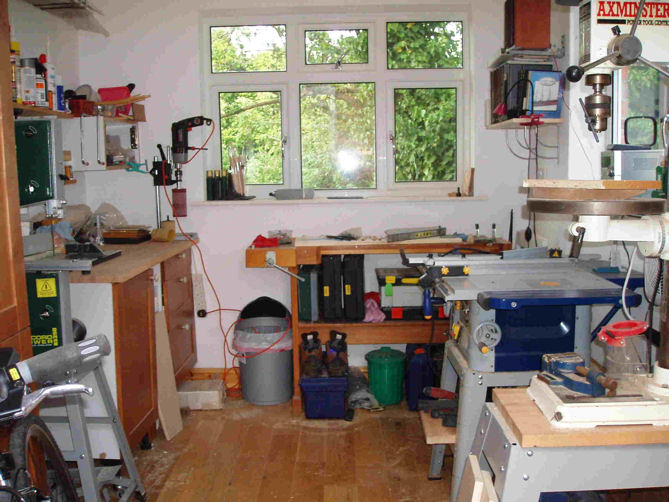
The big old pillar drill at front right I have had for ever, but the table-saw behind it and the band-saw poking out from the left are both relatively new.
Spare time has also allowed me to think through some reuse of old tools. On the back wall beside the window is a thirty five year old Black and Decker drill fitted to a small stand. In its day it was my DIY monster, capable of driving through the flint walls that we had at the time. It has been superseded by a De Walt SDS drill for serious work on the house, but is happily doing service as a bobbin sander.

Likewise, I have a nice new slow speed grinder for tool sharpening. But instead of throwing away my old engineering grinder that used to burn the temper off delicate chisels in a matter of seconds, I have stripped off the wet wheel, turned the guard round so that the dry wheel spindle runs away from me and replaced the grinding wheel with a felt wheel. Voila, grinder at the front and an excellent polisher behind it.
So, no output yet, but the chisels and planes are honed, oiled and carefully stored in drawers and cupboards, the saw blades have been filed sharp and pins on the marking gauges have been brought to a perfect cutting edge. So, as the light evenings lengthen, my back orders of bookcases, planters and bird tables will be a nice quiet way to end the day, after the relentless toil of a vegetable growing brick layer.
It is when I am in the workshop that I really feel the joy of time to spare. No short cuts, no compromises and if something doesn't get finished today, then there is always tomorrow. Of course Tony must feel like this all the time, lucky guy.
The way forward
The last year has sped past and I should have started a retirement plan by now, rather than just potter about, but I have discovered something important which makes a plan of my retirement time totally unnecessary.
Time is the most precious thing any of us possess, but because we can never know how much of it we possess, it is meaningless to try to allocate time by reference to worth, importance or utility. The only thing that makes any sense is to follow our hearts. For some, this may well mean detailed time planning, but for me it means flitting between tasks, adroitly avoiding the dark demon of boredom. Does this mean no planning? Not at all; as General Eisenhower said, "Going into battle, a plan is useless, but planning is essential." I will carefully plan the joints I want to use in a piece of woodworking, carefully plan crop rotation on my vegetable plot and carefully calculate the body mass index I want to achieve; but, from now on, you will never hear me say that I will finish something by next Friday. That will be the real joy of my retirement.
Last updated 20 November 2009